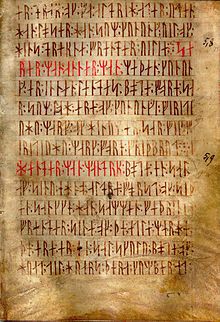Codex Runicus
The Codex Runicus is a 202-page codex that was written around the year 1300 in Scandinavian runes . It contains the oldest surviving Scandinavian national law , the Scandinavian law ( Skånske lov ). The Codex Runicus is one of the few runic texts written on parchment and is now part of the Arnamagna Collection under the signature AM 28 8vo .
execution
The initials of the manuscript are in different colors, the rubrics (headings) in red.
In the medieval Scandinavian runic alphabet, a character is assigned to each phoneme in the Danish language. Some characters of the older Futhark are replaced by new ones, such as a "dotted" k- rune for the g and a t- rune with a crossbar for the d . The runes themselves are slightly rounded, but all in all only slightly adapted to the needs of writing with ink and parchment. Rounded forms of runes also occur elsewhere. A continuous use of runes in Scandinavia from the Viking Age to the high Middle Ages is therefore not proven.
Only a short fragment (“SKB A 120”) has survived from the only other known Scandinavian runic manuscript from this period. It is a lamentation of Mary . Both manuscripts are similar in both the shape of the runes and the language used. This suggests that they were either written by the same Skåne artist, or at least originated in the same scriptorium .
content
The manuscript consists of three large parts: the Scena law (fol. 1–82), the Scena canon law (fol. 84–91), plus a historical part with a chronicle of the Danish kings of Frotho I , the son of the legendary King Hadding, up to Erik VI. (fol. 92–97) and a description of the Danish - Swedish border (fol. 97–100).
For example, the text of the first heading on page 27r reads:
- Særær man annær man mæþæn kunung ær innæn lændæs bøtæ fore sar sum loh æræ: ok kunungi firitiuhu mark ok hinum ær sar fik firitiuhu mark fore friþbrut.
- (If a man wounds another man while the king is in the country, he should pay a fine for the wound according to the law, and 40 marks to the king, and 40 marks to the one he wounded for breaking the peace. )
The two legal texts were probably written by the same scribe, while the historical material of the Codex, from sheet 92 onwards, was probably inserted by someone else at a later date.
Drømt mik and drøm i nat
On the last page of the manuscript there is a verse with notes ( neumes ) - the oldest musical notation found in Scandinavia. However, the interpretation is unclear.
The text says:
" Drømde mik æn drøm i nat
um silki ok ærlik pæl "
"Last night I dreamed a dream
of silk and fine fur / of right and honest play"
For a few years the melody was the pause signal at Danmarks Radio .
Web links
- Digitized version of the entire Codex Runicus on the website of the University of Copenhagen
- Audio file from Drømde mik en drøm i nat ( WAV ; 712 kB)
literature
Johannes Brøndum-Nielsen, Svend Aakjær, DJ Jørgensen: “Skånske lov, Danmarks gamle landskabslove”, vol. I. København 1933.
Individual evidence
- ↑ “Det Arnamagnæanske Haandskrift No 28, 8vo: Codex Runicus”. Commissions for the Arnamagnæanske Legat, København, 1877.
- ↑ z. B. Bone carving from Lund (Sweden)
- ^ Britta Olrik Frederiksen: "The Nordic Languages: An International Handbook of the History of the North Germanic Languages", Volume 1. Walter De Gruyter. Berlin, 2003. ISBN 3-11-014876-5 (pp. 819–823)
- ↑ Britta Olrik Frederiksen: "The History of Old Nordic manuscripts IV: Old Danish". 2003. (p. 821: "... it has been suggested that the two manuscripts come from the same scriptorium ...")
- ↑ Det Danske Sprog- og Litteraturselskab (DSL): Kulturhistorisk baggrund (accessed on November 17, 2011)



